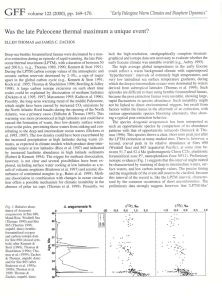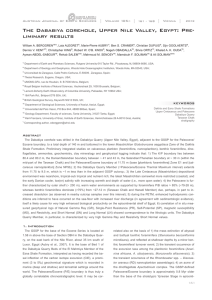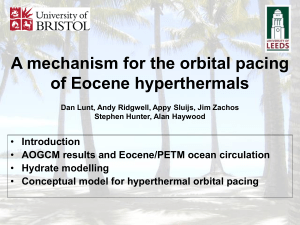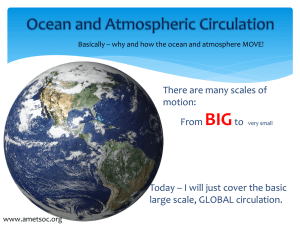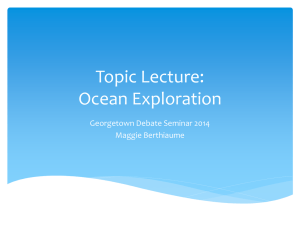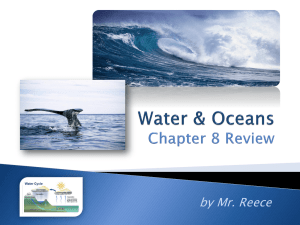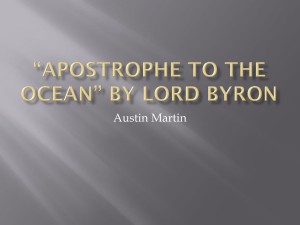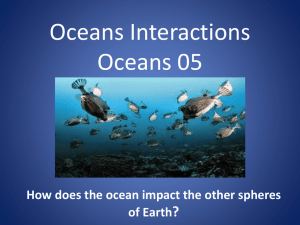o C - Max-Planck-Institut für Meteorologie
advertisement
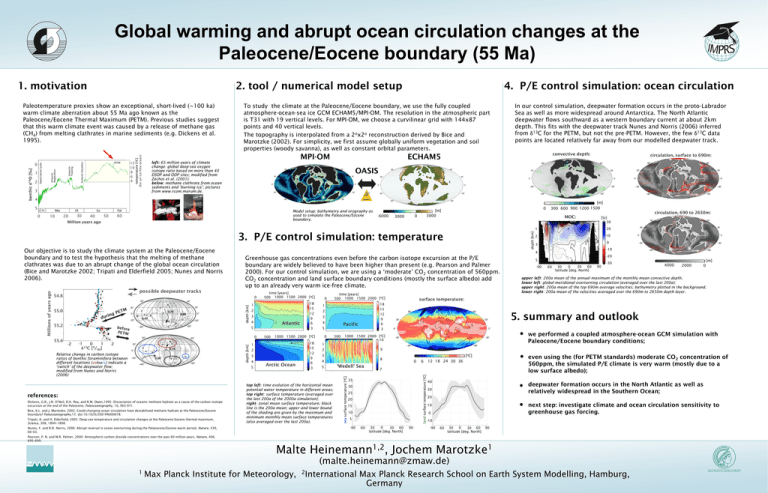
Global warming and abrupt ocean circulation changes at the Paleocene/Eocene boundary (55 Ma) 1. motivation 2. tool / numerical model setup 12 10 8 6 4 benthic δ18O [‰] 0 1 2 temperature [oC] (for an ice-free ocean) Paleotemperature proxies show an exceptional, short-lived (∼100 ka) warm climate aberration about 55 Ma ago known as the Paleocene/Eocene Thermal Maximum (PETM). Previous studies suggest that this warm climate event was caused by a release of methane gas (CH4) from melting clathrates in marine sediments (e.g. Dickens et al. 1995). 3 4. P/E control simulation: ocean circulation To study the climate at the Paleocene/Eocene boundary, we use the fully coupled atmosphere-ocean-sea ice GCM ECHAM5/MPI-OM. The resolution in the atmospheric part is T31 with 19 vertical levels. For MPI-OM, we choose a curvilinear grid with 144x87 points and 40 vertical levels. The topography is interpolated from a 2ox2o reconstruction derived by Bice and Marotzke (2002). For simplicity, we first assume globally uniform vegetation and soil properties (woody savanna), as well as constant orbital parameters. MPI-OM left: 65 million years of climate change: global deep-sea oxygen isotope ratio based on more than 40 DSDP and ODP sites; modified from Zachos et al. (2001); below: methane clathrate from ocean sediments and ‘burning ice’; pictures from www.rcom.marum.de. In our control simulation, deepwater formation occurs in the proto-Labrador Sea as well as more widespread around Antarctica. The North Atlantic deepwater flows southward as a western boundary current at about 2km depth. This fits with the deepwater track Nunes and Norris (2006) inferred from δ13C for the PETM, but not the pre-PETM. However, the few δ13C data points are located relatively far away from our modelled deepwater track. convective depth: ECHAM5 OASIS 4 5 0 20 10 30 40 Model setup; bathymetry and orography as used to simulate the Paleocene/Eocene boundary. 60 50 Million years ago -6000 0 3000 0 [m] 3000 55.0 55.2 55.4 2 3 4 Atlantic 5 0 -2 -1 1 0 δ13C [0/00] 2 Relative change in carbon isotope ratios of benthic foraminifera between different locations (colours) indicate a ‘switch’ of the deepwater flow; modified from Nunes and Norris (2006) Dickens, G.R., J.R. O’Neil, D.K. Rea, and R.M. Owen,1995: Dissociation of oceanic methane hydrate as a cause of the carbon-isotope excursion at the end of the Paleocene, Paleoceanography, 10, 965-971. Bice, K.L. and J. Marotzke, 2002: Could changing ocean circulation have destabilized methane hydrate at the Paleocene/Eocene boundary? Paleoceanography,17, doi:10.1029/2001PA000678. Tripati, A. and H. Elderfield, 2005: Deep-sea temperature and circulation changes at the Paleocene-Eocene thermal maximum, Science, 308, 1894–1898. 500 depth [km] 1 20 2 10 0 3 -10 18 15 12 9 6 3 2 3 4 2 3 4 Arctic Ocean Pacific 5 0 500 60 30 60 30 0 latitude [deg. North] 90 1 Max Planck Institute for Meteorology, 2000 0 upper left: 200a mean of the annual maximum of the monthly mean convective depth; lower left: global meridional overturning circulation (averaged over the last 200a); upper right: 200a mean of the top 690m average velocities; bathymetry plotted in the background; lower right: 200a mean of the velocities averaged over the 690m to 2650m depth layer. 3 [oC] 8 4 ‘Wedell’ Sea 0 6 12 18 24 30 36 7 35 30 25 20 15 10 5 60 even using the (for PETM standards) moderate CO2 concentration of 560ppm, the simulated P/E climate is very warm (mostly due to a low surface albedo); 0 30 60 30 latitude [deg. North] 90 40 deepwater formation occurs in the North Atlantic as well as relatively widespread in the Southern Ocean; 30 20 next step: investigate climate and ocean circulation sensitivity to greenhouse gas forcing. 10 0 -10 -90 60 0 30 30 60 latitude [deg. North] 90 Pearson, P. N. and M.R. Palmer, 2000: Atmospheric carbon dioxide concentrations over the past 60 million years, Nature, 406, 695–699. Malte 4000 [m] 9 -90 Nunes, F. and R.D. Norris, 2006: Abrupt reversal in ocean overturning during the Palaeocene/Eocene warm period, Nature, 439, 60–63. -90 -30 we performed a coupled atmosphere-ocean GCM simulation with Paleocene/Eocene boundary conditions; 1000 1500 2000 [oC] 10 2 top left: time evolution of the horizontal mean potential water temperature in different areas; top right: surface temperature (averaged over the last 200a of the 2000a simulation); right: zonal mean surface temperature; black line is the 200a mean; upper and lower bound of the shading are given by the maximum and minimum monthly mean surface temperatures (also averaged over the last 200a). 5 5. summary and outlook 1 5 -20 surface temperature: 18 15 12 9 6 3 1 1000 1500 2000 [oC] 1 5 references: 18 15 12 9 6 3 1 0 time [years] 500 1000 1500 2000 [oC] land surface temperature [oC] depth [km] 0 time [years] 500 1000 1500 2000 [oC] sea surface temperature [oC] 54.8 Greenhouse gas concentrations even before the carbon isotope excursion at the P/E boundary are widely believed to have been higher than present (e.g. Pearson and Palmer 2000). For our control simulation, we are using a ‘moderate’ CO2 concentration of 560ppm. CO2 concentration and land surface boundary conditions (mostly the surface albedo) add up to an already very warm ice-free climate. circulation, 690 to 2650m: [Sv] 30 4 depth [km] Millions of years ago possible deepwater tracks [m] 300 600 900 1200 1500 MOC: 3. P/E control simulation: temperature Our objective is to study the climate system at the Paleocene/Eocene boundary and to test the hypothesis that the melting of methane clathrates was due to an abrupt change of the global ocean circulation (Bice and Marotzke 2002; Tripati and Elderfield 2005; Nunes and Norris 2006). circulation, surface to 690m: 1,2 Heinemann , Jochem 1 Marotzke (malte.heinemann@zmaw.de) 2International Max Planck Research School on Earth System Modelling, Hamburg, Germany



